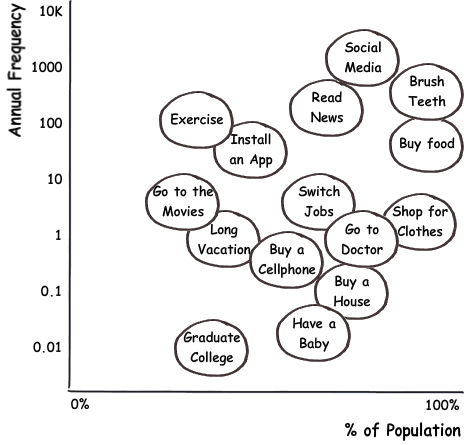Playing in the right business zone
If you are a product manager, by title or role, you are probably familiar with the matrix describing where you should spend your resources. It states that features that are used by most users most of the time are worth spending more than features that are either used by just a few users or just a few times in the users journey through your product.
What if we superset this thinking into your whole business. What if instead of “your users” we use “all population” and instead of feature usage we replace it with an individual annual need for your product.
For example, buying a house is something that is done by about 60% of the US population, and they stay in their house for an average 13 years. That means between age 25 and 80, individuals that buy a home might go through that process only four times in their lifetime. Another example is reading the news. Approximately 80% of adult Americans read the news on a daily basis.
If you collect enough of these events and plot on a chart, you end up with something like this.

What’s not represented in this chart is the dollar value of the transaction. Although the average person might buy a new cellphone just about the same number of times that she takes a long vacation, one has a cost of a couple hundred dollars while the other is about a few thousand.
That line of thinking led me to the idea opportunity zones chart. It’s meant to represent opportunities for VC-scale business, not services business, not mom & pop business, not big business expansion, but startups that can become big business.

No startup zone: This is where you have people life events that happen just about once or twice in a lifetime and by very few people. It’s very hard to jump start a business in this segment.
Tough to scale zone: Even though it could happen somewhat often, the lack of mass demand means this is possibly a very fragmented target audience and unless you can have a high per-transaction profit, you can’t build a big business. Imagining serving very few customers, but making a lot of money from each.
I’m doing it for passion zone: It’s just like the Tough to scale zone, but you could build a decent business here. It probably is not a VC business because it doesn’t have the $100M in revenue potential (that’s the bar for some VCs to even consider your startup). However, if you can bootstrap or use some other form of capitalization you can have a good deal for yourself.
High ticket price zone: This is a very exciting zone if you are talking about transactions into the thousands, tens of thousands or hundreds of thousands of dollars. Even though is not super frequent transaction, it is frequent enough for the number of people doing it that you can reach revenue scale.
Only basic human needs zone: If you can figure one of the basic human needs that inhabit that zone — people must have it — then go for it, but the frequency is low enough that a nice-to-have would not survive in there. A few examples of events in this zone is picking a new school for your child or replacing the furnace in your home.
You need a big brand zone: Things that you do once every one to ten years, like buying a new car, a house or even a mobile phone. The reason you need a brand is because of discoverability. You won’t be top of mind for folks if they don’t do it that often. That’s why car companies spend so much money on brand awareness campaigns. BMW needs to create a very strong brand image over a long period in your mind for when you are ready to buy a luxury car to pick their product. You are better off playing the fat startup game, than the lean one if you want to play in this zone.
Finally, the last two zones on the top right are where you want to play. The “red ocean” zone is where you’ll see the highest number of competitors and unless you have something that’s a technology breakthrough or is a unique and clearly better (a.k.a. revolutionary) value proposition, your screams for attention will drown in the middle of a thousand others doing the same thing. The unicorns are here. There are riches, but it’s a winner takes it all game. This zone represents mobile gaming, photo sharing, social media, e-commerce/marketplaces, etc.
But the zone just below the red ocean is where the most opportunities exist for startups. Where people might do a task from a couple times a year to a couple times a week. Where it’s not a 100% penetration as to not be obvious to everyone this is a problem, but it’s not such a small segment of the population to make it unattractive. This is where gender-specific needs exist (like Dollar Shaving Club, Stitch Fix & Julep), or popular hobbies solutions (for fitness, cooking, book reading, blogging), or entertainment (video games, niche content sites).
If you are in the early days of your startup and building a big VC-backed business is your goal, I’d advise you to think how you can increase the frequency a customer transact/experiences your product and how you can create a broader appeal. It doesn’t mean you have to tackle the biggest market you can think of, but you have to be able to articulate how you’ll find a wedge into the market and expand from there.